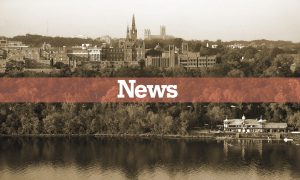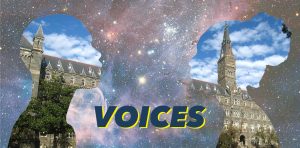For students involved in religious groups, last year’s challenges—Zoom burnout, a lost sense of community, and academic stress, among others—were compounded by another: balancing online obligations while also practicing faith and caring for mental health.
While campus ministry and student-led religious groups continued to hold some virtual services during the online year, they lacked both the attendance and community atmosphere of pre-pandemic services. Since the return to Georgetown and the resume of in-person religious services, practicing one’s faith has become easier and more rewarding for many students.
“The return to campus has been challenging as we attempt to shift our previously Zoom-based activities to in person and then adapt as necessary, but it’s very much worth the challenge,” Jenna Antonacci (COL ’24), social chair of Catholic Women, wrote in an email to the Voice. Antonacci, who also participates in other Catholic ministry groups, added that Catholic Women has held gatherings outdoors when possible, but also hosted fully masked, indoor events.
Now that students are back on campus, religious services of all kinds—from Jewish Life’s Friday Shabbats to Dharmic Life’s weekly Āratī—have seen more engagement. Being in-person, students could now better connect with one another through shared worship, meditation, and meals.
“Āratī is every Sunday, and having dinner with everyone has always been like a highlight of my time at Georgetown,” Sannidhi Shashikiran (NHS ’22), resident of the Hindu Students Association (HSA), said. “Not having that during the pandemic was really sad, and having it in a different way just really wasn’t the same doing it over Zoom.”
Having a shared physical worship space is a key part of building the religious communities that are valued by so many students. “It’s really nice to have a community to fall back on, to go to the masjid and know that I can just feel comfortable with everybody there feels really nice,” Sabreen Mohammed (NHS ’24), Muslim Student Association’s (MSA) director of interfaith and intrafaith relations, said. The VCW masjid opened in August 2019, and this semester, Muslim Life held an masjid open house.
Events organized and sponsored by religious groups also grew after the return to campus. Among the events held this semester was the Dharmic celebration of Diwali, (or Kartik Mela, the festival of lights) which featured clay candles made by the HSA, a charity dinner, and student-led performances.
“We had 20 to 30 students perform in total, and a combination of singing, dancing, and playing culturally significant instruments,” Shashikiran said.
For the Chiristian Orthodox community, the major event of this semester was a visit from the Orthodox Patriarch Bartholemew I, who was in the U.S. in October to meet with President Joe Biden and receive an honorary degree from the University of Notre Dame for his environmental activism; Patriarch Bartholemew is known to many as the ‘Green Patriarch.’ He blessed the Orthodox icons in the Copley Crypt, where the Orthodox community worships, and attended a dinner reception open to all students and faculty.
“It was a really exciting experience for us—once in a lifetime really—and a true blessing and a joy to welcome him to our campus. Whether Orthodox or not, I think all students, or anyone really, can learn from him because he places a lot of emphasis on interfaith dialogue and environmental conservation,” Antonia Sames (COL ’23), co-president of Georgetown’s branch of the Orthodox Christian Fellowship, said.
Community service, made challenging by last year’s virtual environment, was an integral facet of all religious groups’ in-person experiences. This year, many service projects were interfaith, being organized by one faith group but open for all groups to participate. For example, the Orthodox Christian Fellowship organized an event in November during which Dharmic, Jewish, Christian, and Islamic students gathered under a tent in Dahlgren quad to assemble hygiene kits for the International Orthodox Christian Charities (IOCC).
“We order supplies and assemble kits and then IOCC will send these abroad to where they feel there’s the most need for them. So we’ll be working together with Catholic women at Georgetown, Knights of Columbus, Hindu Student Association, Jewish Student association, and any other groups who are interested in joining,” Sames explained.
Individual religious groups have held their own service projects, too. This semester, the Muslim Students Association (MSA), for example, began working with Project RISHI (Rural India Social and Health Improvement) to make education about menstruation, as well as reusable menstrual products themselves, more accessible in two northern Indian villages—Nokheda and Rudlai.
“There’s a lot of taboo and stigma about talking about menstruation, especially with learning about how to best communicate like educational interventions and campaigns and like those villages,” Mohammed said.
The Hindu Students Association, meanwhile, began a partnership with Prerna this semester, an organization that works to combat human trafficking in Mumbai, India.
“They work to end trafficking in their red light district, so they do a lot of helping girls like access education and having that pathway set up for them, and working with children of women that do sex work,” Shashikiran said.
In addition to building new connections and undertaking service projects, students returned to campus with new spaces to worship. The Dharmālaya, a place of worship and meditation for Dharmic faiths, opened in the Leavey center on Nov. 4. Students have been advocating for a permanent Dharmic meditation space for years, and Georgetown’s Dharmālaya is the first of its kind to open on any U.S. college campus.
“It’s the first time that we’ve had that kind of space, which has been like a pretty significant thing for us,” Sargun Kaur (SFS ’23), president of Georgetown’s Sikh Student Association (SSA), said.
While SSA uses the Dharmālaya as a meditation space, Sikh students travel off-campus to their primary worship space. Once a month, students visit the National Gurdwara near the National Cathedral; these trips are organized by the SSA but open to all interested students.
Community-building events and projects, like the monthly trips to the Gurdwara, have been crucial for all groups. To strengthen their group bonding, the MSA, HSA, and JSA (the Jewish Students Association) have created and continued mentorship programs, in which upperclassmen are paired with underclassmen to bond with and introduce the new students to their groups.
“Everybody is very sweet. I think that big/little program also really helped in building community and making friends this semester,” Mohammed said.
The communities that students have found in religious groups on Georgetown’s campus have emerged stronger after the pandemic, as more students have taken advantage of the in-person opportunities offered.
“We have a Jewish Life retreat every semester, and I went on that during the first weekend of November this year. We went with Rabbi Rachel to the CCC [the Calcagnini Contemplative Center, Georgetown’s retreat center] and we just relaxed for about 40 hours. This time the theme was specializing on [the] self, the qualities of the self that you find in God and how to perfect them through meditation,” JSA member Melinda Blumenstock (COL ’23) said.
For Blumenstock, the return to campus made it easier for her to reconnect with her faith and bond with Georgetown’s Jewish community through the retreat and in-person services, both of which were difficult during the virtual year.
“When I was younger, I went to services every week,” Blumenstock said. “ I feel like Jewish life at Georgetown has helped me reconnect. It’s not a two hour long service, and it’s not all in Hebrew, which helps me. It’s a nice way to stay in touch with Judaism.”
The post-Zoom return to religious services has also brought increased engagement. SSA, for example, saw their attendance rise from around five members pre-pandemic to around 15 this semester. HSA, MSA, JSA, and Christian student groups also saw increases in religious involvement in the student body—particularly among first years and sophomores.
“It’s really great to see high turnout freshman and sophomore-wise, and to see that they’re so engaged and excited about all the things that we do on Georgetown’s campus. So I’m really excited to kind of see that go forward as well, and now that we have the prayer space, I really think that’s going to have a big impact,” Shashikiran said.
Challenges remain for religious groups, including social distancing requirements and pandemic-related budget cuts. Both Campus Ministry faith groups and student-led groups have nonetheless persevered in both accommodating these challenges and allowing students of religious faiths to connect in ways that weren’t possible during the virtual year.
“There will be a readjustment to having neighbors again, smaller budgets, and new means of engaging students, each of which will require grace, creativity, and growth,” Matt Hall, associate director for Residential Ministry on the Main Campus, wrote in a Campus Ministry blog post. “We continue to engage [students] through open houses, weekly pastoral reflections, one-on-one conversations, on-call response in the middle of the night, and much more.”
This article has been updated to reflect the proper spelling of “Āratī.”





